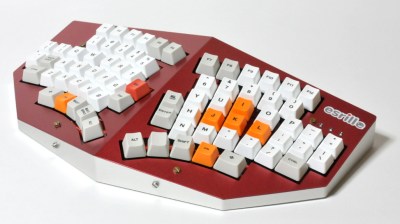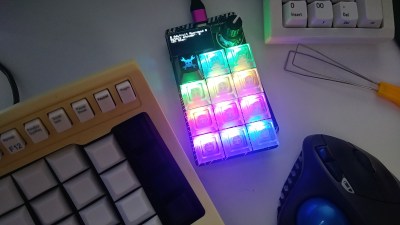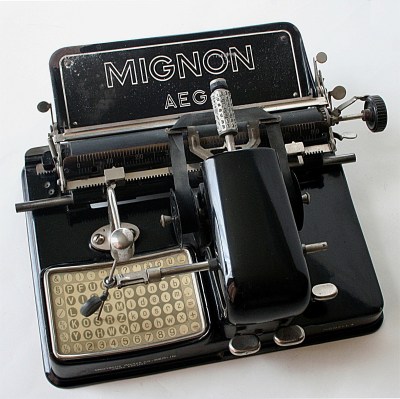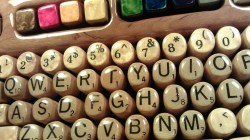
You may have noticed that I neglected to write an introductory paragraph for the last one of these — I was just too excited to get into the keyboards and keyboard accessories, I guess. I can’t promise that I’ll always have something to say up here, but this week I definitely do: thank you for all the tips I’ve received so far! The readers are what make Hackaday great, and this little keyboard roundup column is no exception. Fabulous fodder, folks!
Kamina Chameleon
![[deshipu]'s DIY keyboard with various center modules](https://hackaday.com/wp-content/uploads/2021/08/de%CA%83hipu-Kamina.png?w=400)
The latest version is the Kamina, a one-piece split with a SAMD21 brain that is slim and narrow without being cramped. [deʃhipu] started by splitting the Planck layout, spreading it, adding a number row, and eventually, an extra column of Kailh Chocs on the right hand. One-piece splits are great as long as the split suits your shoulders, because everything stays in place. When you do move it around, both halves move as one and you don’t have to mess with the positioning nearly as much as with a two-piece. And of course, since he designed it himself, it fits.
The really cool thing here is the center module concept. It’s functional, it looks nice, and as long as it doesn’t get in the way of typing, seems ideal. So far, [deʃhipu] has made a couple different versions with joysticks, encoders, and buttons, and is currently working on one with a Home button made for cell phones to take advantage of their built-in optical trackpads.
Esrille NISSE Looks Nice
This is the Esrille NISSE keyboard and it comes in two sizes! Okay, the two sizes don’t look that different, but the key spacing specs say otherwise. To me, this looks like an Alice with a better and ortholinear layout. These bat-wing beauties are new to me, but they’ve been around for a few years now and are probably difficult to stumble upon outside of Japan. Although Esrille doesn’t seem to make any other keyboards, they do make a portable PC built on the Raspberry Pi compute module.

I love me a one-piece split when its done properly, and this one seems to be pretty darn close to perfect. How do I know? You can print out a paper-craft version to try out either of the two sizes. I didn’t take it quite that far, but you can bet that I opened the smaller size’s image in a new tab and put my hands all over the screen to test the layout.
I especially like the thumb clusters and the inside keys on this thing, but I think the innermost thumb keys would be too painful to use, and I would probably just use my index finger. I would totally buy one of these, but they’re a little too expensive, especially since the smaller one costs more. (What’s up with that?) The great news is that the firmware is open-source. Between that and the paper-craft models, a person could probably build their own. Check out [xahlee]’s site for a review and a lot more pictures of the NISSE and similar keebs.
Check This Out: Making Double Shot Polyurethane Keycaps
There’s more than one way to put legends on keycaps, and the double shot method is definitely the longest-lasting. Double shot keycaps are kind of what they sound like — they’re made in two pieces; one for the legend, and one for the rest of the keycap. Double shot keycaps are awesome because you can’t feel the legends and it’s impossible for them to wear off. They are forever, and making them requires an intricate process.
This dramatic video that’s set to Ride of the Valkyries doesn’t offer much in the way of explanation, but you will see every single step of this three-day process go by in what feels like more than five minutes. It starts out with a mold made of LEGO, so you might think this is something you can easily pull off in a weekend, but it gets complicated pretty quickly.
Big thanks to both [Inne Lemstra] and [Zane Atkins] for tipping about this one. The system works!
New Hotness: Adafruit’s RP 2040 Macropad
I got my Adafruit ADA BOX this week and (spoiler alert!) it features their Raspberry Pi RP2040-based macropad. The idea here is that you can scroll through and select different macro group profiles with the rotary encoder giving you nearly limitless bindings in a small package. You can use RGB to tell your menus apart, and you get enough space on the OLED to show a short label for each of the 12 keys that appear in a matching matrix.

Adafruit sent these out with Kailh reds (linear switches), which are totally not my jam, but I know linears are popular, and I suppose it’s better to err on the side of silence rather than clack a bunch of people into annoyance. I used a dozen Cherry MX clears at first, but those have all-black enclosures and don’t let the RGB through as well (though I think they look pretty cool anyway). Pictured here are Kailh box whites, which have clear upper housings, and they’re topped with the included translucent DSA keycaps.
Yes, that’s a Jolly Wrencher in the upper left! I was quite fortunate to receive an extremely limited-edition Hackaday keycap that’s 16 years in the making (thanks pt!). If you missed our Python Your Keeb Hack Chat with the crew from Adafruit, go check it out and peep this video of double shot beauty of a keycap. I’m not yet sure what I’ll do with my macro pad. I’m leaning towards work-related shortcuts, or maybe creating some kind of game that requires cranking the rotary encoder and pushing the keys somehow.
Historical Clackers: Index Typewriters

Index typewriters were invented in 1880 and fell out of fashion by the 1940s. They are called so for one of two reasons: either because it uses a pointer to choose from an index of characters, or because you use your index finger to work the pointer.
In either case, the pointer is mechanically linked to the corresponding type element that prints the character, and you just push a lever to type after making your selection. A second lever does the work of the space bar.
There were a few different styles of index typewriter over the years, and many of the designs are interesting. Compared with typewriters, they were all relatively small and lightweight, and cheaper to manufacture without the keyboard. As a result, index typewriters were mainly marketed to writers on the go.
The index typewriter is still around in the form of the handheld embossers that predate the electronic label makers of today. Many label makers and index typewriters are laid out alphabetically, and some had their own non-qwerty layouts.
In Case You Missed It
Have you ever heard of magnetic, Hall-effect key switches? You bet they’re the height of clacky. Well, [riskable] is bringing them back en vogue with a modern twist. These are magnetic separation switches in the sense that actuation forces two magnets apart, yes. But they’re also magnetic levitation switches — instead of a spring, there’s a third magnet in the keycap that helps it return to the home position.
![[riskable]'s clacky magnetic switches](https://hackaday.com/wp-content/uploads/2021/07/mag-lev-void-keyswitches-800.jpg?w=250)

What’s better than an IBM Model M? Not much if you ask us, but then we saw [Steve M. Potter] take all these lovely buckling spring switches and give them handmade wooden keycaps with Scrabble tile veneers. What a high-scoring build!
Got a hot tip that has like, anything to do with keyboards? Help me out by sending in a link or two. Don’t want all the Hackaday scribes to see it? Feel free to email me directly.
No comments:
Post a Comment